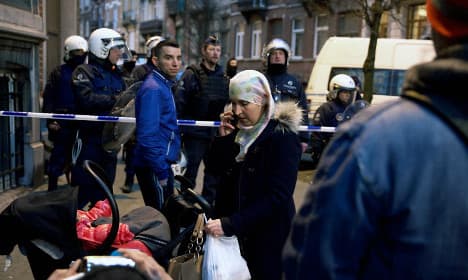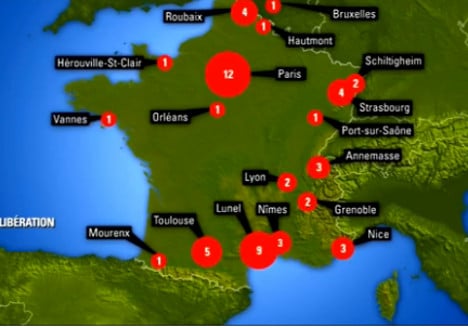Is France really home to '100 Molenbeeks'?

A French minister has struck a raw nerve after stating France is home to 100 Molenbeeks – referring to the Brussels suburb known to be hotbed for jihadists. But is he correct? “Today, we know that there are 100 neighbourhoods in France that have potential similarities with what happened in Molenbeek.”
These were the words of French communities minister Patrick Kanner which have caused a storm in France.
Kanner was answering a question on radio about the Brussels suburb of Molenbeek, which was the home of several of the jihadists who attacked Paris last November and since then has developed a reputation for being a hotbed of Islamic extremism.
“Molenbeek… where there is an enormous concentration of poverty and unemployment, an ultra-communitarianist and mafia system, with an underground economy where public services have almost disappeared and the elected officials have given up,” said Kanner.
The statement was welcomed by those on the right and far right, where similar views have long been offered.
The National Front’s number two in charge, Florian Philippot, even thought Kanner’s estimate of 100 was too optimistic, but called his words “lucid”.
"For once we have a minister, Mr. Kanner, who has lifted the veil of blindness that covers the eyes and mouth, that is speaking a truth clearly..." Philippot said.
And Prime Minister Manuel Valls, who made waves in the aftermath of the Charlie Hebdo shooting by talking of the problem of “social and ethnic apartheid” that is the scourge of some French cities, partly supported Kanner.
While he said the comparison with Molenbeek wasn’t appropriate he accepted that “a process of seclusion, communitarianism and radicalization does indeed exist” in certain areas.
In the past Valls spelled it out in clearer terms: “The risk in these territories is that extremism, criminality and radical Islam find fertile ground”.
However Kanner’s statement was greeted with anger on the left with head of the Socialist Party Jean-Christophe Cambadélis who lamented the fact that Muslims in those neighbourhoods or towns will feel “stigmatized”.
Socialist MP Julian Drey criticized the statement for bearing “no real information.”
With Kanner not specifying all the areas he was referring to, politicians and media have taken it upon themselves to identity France’s very own Molenbeeks.
BFM TV chose to point out where all the French jihadists killed fighting in Syria hailed from (see map below).

Many came from the suburbs around Paris, with Trappes in the south and Sevran in the north being named as potential Molenbeeks.
There is also the small town of Lunel in southern France, which was identified as a hotbed for jihadism after it emerged that around 20 residents had left for Syria.
The neighbourhood of Les Izzards in Toulouse has also been mentioned. This “quartier sensible” became notorious in 2012 as the home of self-proclaimed Islamist Mohamed Merah, who gunned down soldiers, a rabbi and Jewish children in a shooting spree.
A police source told AFP there were "plenty of little Molenbeeks" in France.
"It's not exclusively suburbs but areas where we see the significant influence of Salafists and hubs of radicalisation. It tends to be beyond the control of security forces," the source said.
But experts have pointed out that jihadists have left France came from comfortable middle-class backgrounds before heading off to Syria and from all kinds of villages, towns and cities to fight in Syria.
The example of Maxime Hauchard has also been given. Hauchard, a convert to Islamist extremism at the age of 17, was from the tiny village of Bosc-Roger-en-Roumois in Normandy. He has featured in several of the Isis execution videos used for propaganda.
The elected officials in charge of some of the towns and neighbourhoods picked out as potential Molenbeeks in France have reacted furiously.
“If we begin stigmatizing towns, where will this end?” said the mayor of the poor Paris suburb of Sarcelles.
Yves Jego, the furious mayor of Montereau-Fault-Yonne (Seine-et-Marne) a town to the south east of Paris, stressed that towns should not be stained by actions of a tiny minority.
“The vast majority of those living in Molenbeek or in our suburbs are just citizens like all the others who respect the laws and values of Europe," Jego said.
France’s former specialist counter-terrorist judge Marc Trévedic warned against identifying certain areas, insisting that extremists can come from anywhere, even the plush “16th arrondissement of Paris”.
“The nice areas can also act as a hiding place, which would be a good strategy for someone to conceal themselves,” Trévedic told BFM TV.
Experts have also warned against reducing the problem to a link between poverty and extremism.
"If we compare social characteristics, we will find French neighbourhoods that look like Molenbeek, from the point of view of poverty and unemployment, but that doesn't mean there's an automatic and simple link between poverty and groups engaged in jihadist ideology," said Antoine Jardin of the Centre for European Studies at Sciences Po university in Paris.
Comments
See Also
“Today, we know that there are 100 neighbourhoods in France that have potential similarities with what happened in Molenbeek.”
These were the words of French communities minister Patrick Kanner which have caused a storm in France.
Kanner was answering a question on radio about the Brussels suburb of Molenbeek, which was the home of several of the jihadists who attacked Paris last November and since then has developed a reputation for being a hotbed of Islamic extremism.
“Molenbeek… where there is an enormous concentration of poverty and unemployment, an ultra-communitarianist and mafia system, with an underground economy where public services have almost disappeared and the elected officials have given up,” said Kanner.
The statement was welcomed by those on the right and far right, where similar views have long been offered.
The National Front’s number two in charge, Florian Philippot, even thought Kanner’s estimate of 100 was too optimistic, but called his words “lucid”.
"For once we have a minister, Mr. Kanner, who has lifted the veil of blindness that covers the eyes and mouth, that is speaking a truth clearly..." Philippot said.
And Prime Minister Manuel Valls, who made waves in the aftermath of the Charlie Hebdo shooting by talking of the problem of “social and ethnic apartheid” that is the scourge of some French cities, partly supported Kanner.
While he said the comparison with Molenbeek wasn’t appropriate he accepted that “a process of seclusion, communitarianism and radicalization does indeed exist” in certain areas.
In the past Valls spelled it out in clearer terms: “The risk in these territories is that extremism, criminality and radical Islam find fertile ground”.
However Kanner’s statement was greeted with anger on the left with head of the Socialist Party Jean-Christophe Cambadélis who lamented the fact that Muslims in those neighbourhoods or towns will feel “stigmatized”.
Socialist MP Julian Drey criticized the statement for bearing “no real information.”
With Kanner not specifying all the areas he was referring to, politicians and media have taken it upon themselves to identity France’s very own Molenbeeks.
BFM TV chose to point out where all the French jihadists killed fighting in Syria hailed from (see map below).

Many came from the suburbs around Paris, with Trappes in the south and Sevran in the north being named as potential Molenbeeks.
There is also the small town of Lunel in southern France, which was identified as a hotbed for jihadism after it emerged that around 20 residents had left for Syria.
The neighbourhood of Les Izzards in Toulouse has also been mentioned. This “quartier sensible” became notorious in 2012 as the home of self-proclaimed Islamist Mohamed Merah, who gunned down soldiers, a rabbi and Jewish children in a shooting spree.
A police source told AFP there were "plenty of little Molenbeeks" in France.
"It's not exclusively suburbs but areas where we see the significant influence of Salafists and hubs of radicalisation. It tends to be beyond the control of security forces," the source said.
But experts have pointed out that jihadists have left France came from comfortable middle-class backgrounds before heading off to Syria and from all kinds of villages, towns and cities to fight in Syria.
The example of Maxime Hauchard has also been given. Hauchard, a convert to Islamist extremism at the age of 17, was from the tiny village of Bosc-Roger-en-Roumois in Normandy. He has featured in several of the Isis execution videos used for propaganda.
The elected officials in charge of some of the towns and neighbourhoods picked out as potential Molenbeeks in France have reacted furiously.
“If we begin stigmatizing towns, where will this end?” said the mayor of the poor Paris suburb of Sarcelles.
Yves Jego, the furious mayor of Montereau-Fault-Yonne (Seine-et-Marne) a town to the south east of Paris, stressed that towns should not be stained by actions of a tiny minority.
“The vast majority of those living in Molenbeek or in our suburbs are just citizens like all the others who respect the laws and values of Europe," Jego said.
France’s former specialist counter-terrorist judge Marc Trévedic warned against identifying certain areas, insisting that extremists can come from anywhere, even the plush “16th arrondissement of Paris”.
“The nice areas can also act as a hiding place, which would be a good strategy for someone to conceal themselves,” Trévedic told BFM TV.
Experts have also warned against reducing the problem to a link between poverty and extremism.
"If we compare social characteristics, we will find French neighbourhoods that look like Molenbeek, from the point of view of poverty and unemployment, but that doesn't mean there's an automatic and simple link between poverty and groups engaged in jihadist ideology," said Antoine Jardin of the Centre for European Studies at Sciences Po university in Paris.
Join the conversation in our comments section below. Share your own views and experience and if you have a question or suggestion for our journalists then email us at [email protected].
Please keep comments civil, constructive and on topic – and make sure to read our terms of use before getting involved.
Please log in here to leave a comment.